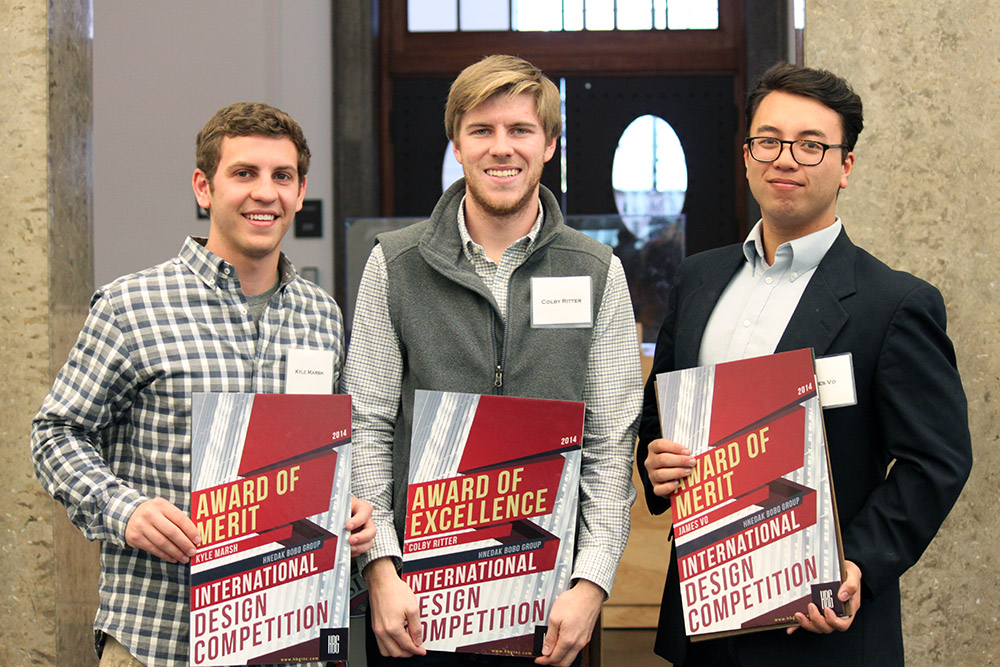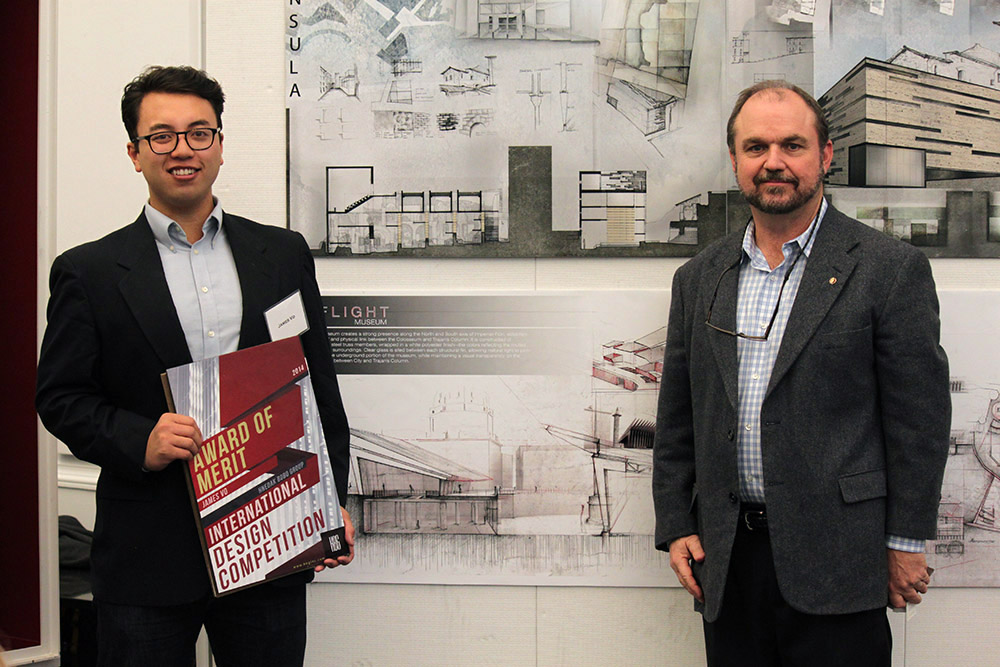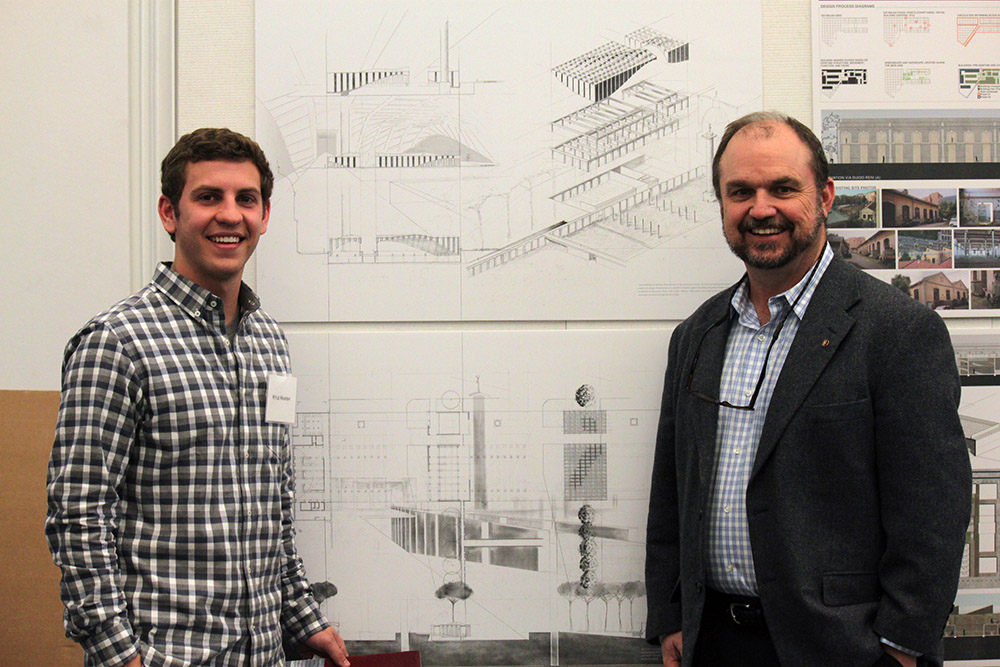
Kyle Marsh, from left, Colby Ritter and James Vo won awards for their study abroad design work in the seventh annual Hnedak Bobo International Design Competition, held in fall 2014. Vo and Marsh won Awards of Merit, receiving $1,000 each, and Ritter won the top award, the Award of Excellence, receiving $3,000. All three are fifth-year students in the professional architecture program. (Photo by Michelle Parks)
By Bailey Kestner
Three students in the Fay Jones School of Architecture created winning designs in the seventh annual Hnedak Bobo International Design Competition, held in fall 2014. The competition recognizes work designed by students while in studios abroad.
James Vo and Kyle Marsh won Awards of Merit, receiving $1,000 each, and Colby Ritter won the top award, the Award of Excellence, receiving $3,000. All three are fifth-year students in the professional architecture program.
Entries in the competition came from students involved in study abroad studios in Mexico City and Rome. Fourth-year architecture students in the Fay Jones School of Architecture are required to spend a semester in either of the two locations for their studio. Vo, Marsh and Ritter all went to Rome in the 2014 spring semester.
“Mexico City and Rome are the two places because they are urban in nature,” said Laura Terry, associate professor of architecture in the Fay Jones School. “In both cities, but Rome in particular, you are able to see layers and layers of history. You can see a Roman ruin next to a 21st century street.”
The two cities provide the students a context that they don’t have here in Arkansas. By spending time in Rome and Mexico City, the students are able to study both the historical contexts in those places, as well as look to what contemporary building needs to happen.
“The hardest thing about being an architecture student studying Rome is that you go to there with knowledge of Roman architecture, but, in classes, you can only ever study it out of context,” Terry said. “Being in Rome allows the students to actually see and experience the architecture.”
A large number of students go to the University of Arkansas Rome Center each semester, including students from the U of A, Auburn University, Louisiana State University, Philadelphia University, and the University of Kentucky.
“This is a great opportunity for our students to work with students from other schools of architecture,” Terry said.
Terry spent two weeks in Rome with her students in spring 2014 and helped the faculty in Rome develop a curriculum that complements the curriculum that the students have in the Fay Jones School. A majority of the students in Rome worked on a library project, and around 12 students worked on a museum project.
Typically between 34 and 50 Fay Jones School architecture students travel to Rome each year, Terry said. Some students actually go to both Mexico City and Rome if they are able to, and it’s something the school highly encourages students to do. The Mexico City studio is only offered in the summer, and about 12 students from the Fay Jones School travel there each year. That studio is directed by Russell Rudzinski, clinical assistant professor.

James Vo, who won an Award of Merit, with Mark Weaver, Fay Jones School alumnus and sponsor of the Hnedak Bobo International Design Competition.
In their studio, Marsh and Vo worked on the museum project involving Trajan’s Forum, the last of the Imperial fora to be constructed in Rome.
“The semester started with studying the city as a whole – from the scale of the city all the way down to the scale of an archeological fragment,” Marsh said. “I was tasked with going underground and being assigned a fragment of an original basilica dated back to around 300 A.D.”
Students in the studio utilized a site of ruins that no one had ever seen or worked with before.
“Everyday Roman citizens have actually never seen it before, and here we are as students partnered with them that actually get to go down there,” Marsh said. “We cleaned, studied and dissected a fragment geometrically and tried to find out where it was from within the church.”
The architecture students took the fragments and used them as catalysts for design for their museum, which was supposed to reintroduce the city of Rome to the ruins that lay under the park.
“Rome has essentially built on top of itself over the course of history,” Marsh said. “You have anything from your ancient Roman ruins, to your 1930s concrete grid implemented by Mussolini, till today, your modern-day Rome.”
The goal of the studio was not only to build a design that housed exhibits, but to also treat the museum itself as an exhibit in the city. Their project lit up at night, becoming a beacon and exposing the site to the city.
The students were careful to maintain views that were important to the surrounding Pieta, Trajan’s Forum and Trajan’s Market. The roof structure was one of the key components of the building, because the students couldn’t change what already existed on the site.
“You can’t tear down walls or put stuff on top of the ruins,” Marsh said. “We used the Roman cobblestones as a design influence. I used a pattern that was familiar with the city that was going to be experiencing the architecture.”

Kyle Marsh, who won an Award of Merit, with Mark Weaver, Fay Jones School alumnus and sponsor of the Hnedak Bobo International Design Competition.
Marsh explained the design as a series of skylight structures – square boxes that extruded down at different depths to create variances in light and shadow throughout the building. The light guided people throughout the museum based on how much light was allotted in the space.
“The museum my group worked on was actually a real project – the city of Rome is going to have a museum on that site,” Marsh said. “Our job was to create a fantastic design that was almost like propaganda to the city.”
The students’ work was put on display in Trajan’s Forum, so the people of Rome were able to see a possible plan of what could be placed there.
“Romans are a bit shy and hesitant to some crazy, new design in their old city,” Marsh said. “We got to kind of be the first to put out fun ideas to see what their reactions would be.”
Ritter worked on a library design in his studio. The project consisted of connecting links of time through the building physically and metaphorically. The building was designed to bridge the space between the top of Trajan’s Market, which has a walkway with only pedestrians on one side, and an urban threshold with both cars and people on the other.
Ritter’s goal was to physically connect the two through a bridge condition, but he also had ruins he tried to connect. The idea was that the geometries of the building would take space based on the ruins that were already at the site. One of the biggest factors was the street space.
“As you walked down the street, you felt enclosed behind the five- to six-story building with an obvious presence, and then there was a big hole where the site was,” Ritter said. “I created a facade for the front of the building that was the same height of the building.”
The facade contained fins that would allow light in, but also created a solid effect that made it look like a solid wall. The main question for Ritter during his project was how to create a library that both acknowledged what had been done in the past, but also what might happen to books in the future.

Mark Weaver, Fay Jones School alumnus and sponsor of the Hnedak Bobo International Design Competition, with Colby Ritter, who won the top award, the Award of Excellence, and a $3,000 prize.
Ritter’s studio created the library with a lot of open spaces and mezzanines for people to sit and study. It was never designated for just shelves of books. It allows for someone to study in any kind of medium through the open spaces of light that allowed the transformation.
The three students agreed that living in Rome for a semester was a huge culture shock at first, but said that it has influenced their perspective on their architecture work.
Vo said that walking by the Pantheon almost every day to school became the norm, and that it was a humbling experience to learn a new culture. A few obvious differences were evident from the start of the trip. Ritter agreed.
“We probably walked a mile and a half to school alone, and probably around six miles a day without even knowing it,” Ritter said. “Now I walk to school from my apartment, and think it’s such a short walk. Before going to Rome, I used to never walk to class.”
The students learned how to adapt to the major differences between life in the United States and Rome over the course of the semester.
“At first I didn’t know what they were saying, and I didn’t even know which way to go in the airport,” Ritter said. “But eventually, you sort of start understanding a few words and how much things cost. It got easier as we stayed there.”
As graduation approaches for the three students in May, they are now considering future plans and how their experience has helped them as designers.
“Winning this award has influenced my designing, from things I personally want to design to knowing and discovering things about architecture,” Marsh said. “It’s also had me question how the award is going to affect my next few years in life. It’s all personal discovery, and then how you get yourself discovered as well.”
Ritter’s fifth-year thesis ties into the work he completed in his Rome studio. His thesis maps the phenomenon of waste in the United States and discusses the cultural differences between here and Rome.
“I don’t think I would have written that thesis if I hadn’t gone to Rome,” Ritter said. “The trip ended up prompting a lot of great ideas.”
Terry said she believes the experiences these three students had in Rome enhanced the education they’ve received in architecture school thus far.
“The three of them are all good students and have done well on their coursework here,” she said. “Just in my short time in Rome with them, it was clear that they were fully immersed: out walking the city every day, drawing all the time, making comparisons and putting all the pieces of the puzzle together. I think by going to Rome, it all really started to click for them.”